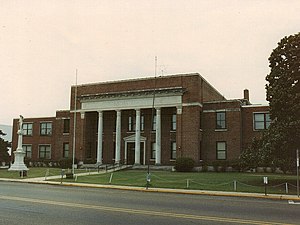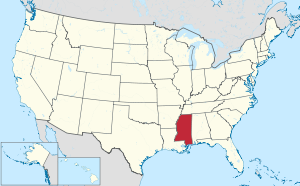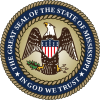Neshoba County, Mississippi
Neshoba County | |
|---|---|
County | |
 Neshoba County courthouse and Confederate Monument in Philadelphia | |
 Location within the U.S. state of Mississippi | |
 Mississippi's location within the U.S. | |
| Coordinates: 32°45′N 89°07′W / 32.75°N 89.12°W | |
| Country | |
| State | |
| Founded | 1833 |
| Seat | Philadelphia |
| Largest city | Philadelphia |
| Area | |
| • Total | 572 sq mi (1,480 km2) |
| • Land | 570 sq mi (1,500 km2) |
| • Water | 1.5 sq mi (4 km2) 0.3% |
| Population (2010) | |
| • Total | 29,676 |
| • Estimate (2018) | 29,125 |
| • Density | 52/sq mi (20/km2) |
| Time zone | UTC−6 (Central) |
| • Summer (DST) | UTC−5 (CDT) |
| Congressional district | 3rd |
| Website | www |
Neshoba County is located in the central part of the U.S. state of Mississippi. As of the 2010 census, the population was 29,676.[1] Its county seat is Philadelphia.[2] It was named after Nashoba, a Choctaw chief. His name means "wolf" in the Choctaw language.[3]
The county is known for the Neshoba County Fair and harness horse races. It is home of the Williams Brothers Store, which has been in operation since the early 1900s.
The Mississippi Band of Choctaw Indians (MBCI), a federally recognized tribe, is based here and has developed one of the largest casino complexes in the state on their reservation. The Silver Star and Golden Moon casinos are the first land-based casinos in Mississippi; these casinos are part of the MBCI's Pearl River Resort in the county.
History[]
At the time of European encounter, this was part of the territory of the historic Choctaw people, who occupied most of what later was defined as Mississippi. Under President Andrew Jackson, the United States conducted Indian removal in the 1830s in the Southeast, and most of the Choctaw were removed to west of the Mississippi River, to land in Indian Territory, now part of Oklahoma.
Neshoba was founded by European American settlers in 1833. They named it after a Choctaw chief, whose name in the Choctaw language meant "wolf".[4]
Descendants of the Choctaw who remained in the state continued to identify as Choctaw. They lived in relatively distinct communities and reorganized in the 1930s, gaining federal recognition as the Mississippi Band of Choctaw Indians. Even in the 1970s, eighty percent of their people continued to speak Choctaw.
Late 19th century to present[]
The white-dominated state legislature passed a new constitution in 1890, that effectively disenfranchised most freedmen and other non-whites, such as Native Americans. This exclusion was maintained well into the 20th century, but activists in the 1960s increasingly worked to restore voting rights throughout the state.
Neshoba County is known as the site of the lynching murder of three young activists in July 1964 during Freedom Summer in Mississippi, a period of education and a voter registration drive to prepare African Americans for voting. The three young men, two from the North, disappeared at a time of heightened violence, and they became the subjects of a state and FBI search. White supremacists were found to have murdered three civil rights activists: James Cheney, Andrew Goodman and Michael Schwerner near Philadelphia, the county seat. During the investigation, searchers found the bodies of eight other young black men in other locations.[citation needed] Deputy Sheriff Cecil Price was implicated and charged with being part of the group that lynched the three young men and buried them in an earthen dam 15 miles northeast of Philadelphia. Outrage over the crime contributed to congressional passage of the Civil Rights Act of 1964 and Voting Rights Act of 1965. The crime and decades-long legal aftermath of investigation and trials inspired the 1988 movie Mississippi Burning.
In 1980 Governor Ronald Reagan launched his presidential campaign at the Neshoba County Fair, delivering a speech about economic policy and referring to "states' rights". He was believed by some to be referring to southern conservative values, in an area associated with the 1964 murders and at a time when the Republican Party was attracting more white conservatives from the Democratic Party.[5][6]
Geography[]
According to the U.S. Census Bureau, the county has a total area of 572 square miles (1,480 km2), of which 570 square miles (1,500 km2) is land and 1.5 square miles (3.9 km2) (0.3%) is water.[7]
Major highways[]
Adjacent counties[]
- Winston County (north)
- Kemper County (east)
- Newton County (south)
- Leake County (west)
Demographics[]
| Historical population | |||
|---|---|---|---|
| Census | Pop. | %± | |
| 1840 | 2,437 | — | |
| 1850 | 4,728 | 94.0% | |
| 1860 | 8,343 | 76.5% | |
| 1870 | 7,439 | −10.8% | |
| 1880 | 8,741 | 17.5% | |
| 1890 | 11,146 | 27.5% | |
| 1900 | 12,726 | 14.2% | |
| 1910 | 17,980 | 41.3% | |
| 1920 | 19,303 | 7.4% | |
| 1930 | 26,691 | 38.3% | |
| 1940 | 27,882 | 4.5% | |
| 1950 | 25,730 | −7.7% | |
| 1960 | 20,927 | −18.7% | |
| 1970 | 20,802 | −0.6% | |
| 1980 | 23,789 | 14.4% | |
| 1990 | 24,800 | 4.2% | |
| 2000 | 28,684 | 15.7% | |
| 2010 | 29,676 | 3.5% | |
| 2018 (est.) | 29,125 | [8] | −1.9% |
| U.S. Decennial Census[9] 1790-1960[10] 1900-1990[11] 1990-2000[12] 2010-2013[1] | |||
As of the census[13] of 2000, there were 28,684 people, 10,694 households, and 7,742 families residing in the county. The population density was 50 people per square mile (19/km2). There were 11,980 housing units at an average density of 21 per square mile (8/km2). The racial makeup of the county was 65.50% White, 19.33% Black or African American, 13.80% Native American, 0.19% Asian, 0.02% Pacific Islander, 0.34% from other races, and 0.81% from two or more races. 1.16% of the population were Hispanic or Latino of any race. 28.6% identified as of American ancestry, 8.8% as Irish and 6.1% as English, according to Census 2000. Those who identify as having "American" ancestry are predominantly of English descent, but have ancestors who came to the US so long ago that they identify simply as American.[14][15] 88.7% spoke English and 10.2% Choctaw as their first language.
There were 10,694 households, out of which 34.90% had children under the age of 18 living with them, 52.50% were married couples living together, 15.60% had a female householder with no husband present, and 27.60% were non-families. 24.70% of all households were made up of individuals, and 11.50% had someone living alone who was 65 years of age or older. The average household size was 2.63 and the average family size was 3.11.
In the county, the population was spread out, with 28.20% under the age of 18, 9.00% from 18 to 24, 27.00% from 25 to 44, 21.60% from 45 to 64, and 14.20% who were 65 years of age or older. The median age was 35 years. For every 100 females there were 91.10 males. For every 100 females age 18 and over, there were 88.30 males.
The median income for a household in the county was $28,300, and the median income for a family was $33,439. Males had a median income of $28,112 versus $19,882 for females. The per capita income for the county was $14,964. About 17.90% of families and 21.00% of the population were below the poverty line, including 27.20% of those under age 18 and 22.00% of those age 65 or over.
Communities[]
Cities[]
- Philadelphia (county seat)
Town[]
- Union (mostly in Newton County)
Census-designated places[]
- Bogue Chitto (partly in Kemper County)
- Pearl River
- Tucker
Unincorporated communities[]
Politics[]
See also[]
- National Register of Historic Places listings in Neshoba County, Mississippi
- Neshoba (film)
- Iris Kelso
Footnotes[]
- ^ Jump up to: a b "State & County QuickFacts". United States Census Bureau. Archived from the original on June 7, 2011. Retrieved September 4, 2013.
- ^ "Find a County". National Association of Counties. Retrieved 2011-06-07.
- ^ Byington, Cyrus (1909). Choctaw Language Dictionary. Global Bible Society.
- ^ Baca, Keith A. (2007). Native American Place Names in Mississippi. University Press of Mississippi. p. 62. ISBN 978-1-60473-483-6.
- ^ Jim Prince: "War over Reagan's Words." Madison County Journal (11/22/2007)
- ^ Montaldo, Charles. "The Mississippi Burning Case". Archived from the original on 2013-03-26.
- ^ "2010 Census Gazetteer Files". United States Census Bureau. August 22, 2012. Archived from the original on September 28, 2013. Retrieved November 6, 2014.
- ^ "Population and Housing Unit Estimates". Retrieved November 9, 2019.
- ^ "U.S. Decennial Census". United States Census Bureau. Retrieved November 6, 2014.
- ^ "Historical Census Browser". University of Virginia Library. Retrieved November 6, 2014.
- ^ "Population of Counties by Decennial Census: 1900 to 1990". United States Census Bureau. Retrieved November 6, 2014.
- ^ "Census 2000 PHC-T-4. Ranking Tables for Counties: 1990 and 2000" (PDF). United States Census Bureau. Retrieved November 6, 2014.
- ^ "U.S. Census website". United States Census Bureau. Retrieved 2008-01-31.
- ^ Lieberson, Stanley & Waters, Mary C. (1986). "Ethnic Groups in Flux: The Changing Ethnic Responses of American Whites". Annals of the American Academy of Political and Social Science. 487 (79): 82–86. doi:10.1177/0002716286487001004.
- ^ Fischer, David Hackett (1989). Albion's Seed: Four British Folkways in America. New York: Oxford University Press. pp. 633–639. ISBN 0-19-503794-4.
- ^ Leip, David. "Dave Leip's Atlas of U.S. Presidential Elections". uselectionatlas.org. Retrieved 2018-03-04.
Further reading[]
- Carol V.R. George, One Mississippi, Two Mississippi: Methodists, Murder, and the Struggle for Racial Justice in Neshoba County. Oxford, England: Oxford University Press, 2015.
External links[]
- Mississippi Region Grapples with Legacy of Civil Rights Murders, a 40th anniversary story from All Things Considered
- Neshoba Democrat's 40th anniversary stories
- Mississippi counties
- Neshoba County, Mississippi
- 1833 establishments in Mississippi
- Populated places established in 1833



